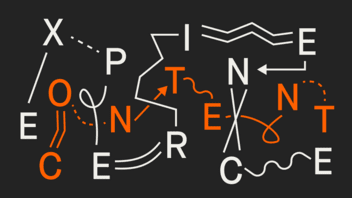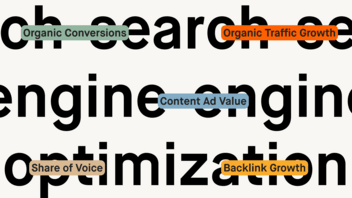Success in content marketing is multidimensional. To define a financial value for calculating content marketing ROI, we use the content ad value.
Content marketing ROI: How to measure it using content ad value
In a nutshell: Content marketing ROI
Marketing’s goal is to drive revenue. If it doesn’t, something’s off. But content marketing success isn’t always measured in financial terms, and direct revenue attribution can be limited due to privacy regulations and tracking challenges.
Still, there’s a way to calculate your content marketing return on investment (ROI). We use what we call the content ad value, a method that shows how profitable your investment in strategic content production really is.
Moccu: Your agency for data-driven content strategies
Want to maximize your content marketing ROI? Boost your visibility, attract qualified traffic, and increase your conversion rate with a content strategy built on precise, data-backed insights.
Unlike traditional marketing campaigns that focus on quick wins, content marketing delivers strategic long-term value that builds over time. It supports long-term growth and performance.
At Moccu, we measure content ROI using the ad value of our content: in other words, what it would cost to acquire the same SEO-driven traffic through Google Ads. Here’s how we calculate it:
- Retrieve all clicks for the content from Google Search Console
- Use Google Keyword Planner to determine the average cost-per-click (CPC) for all keywords
- Multiply clicks by the average CPC to calculate the content ad value
- Divide the content ad value by your content production costs to calculate the content marketing ROI
Why we use the content ad value
According to the sociologist Niklas Luhmann’s systems theory, money is one of the most important means of communication in our society. That’s why we also assign a monetary value to content production in content marketing and use it to calculate a content marketing ROI. For several reasons explained later in this article, it’s difficult to reliably attribute direct revenue generation to content alone.
But reach has value, and many companies spend heavily on campaigns and ads. At Moccu, we assign a financial value to SEO content based on what it would cost as Google Ads – the ad value – and use that figure as the basis for content marketing ROI calculations.
That said: Traffic has a market value. With Google Ads, you can place an ad for any keyword to attract users to your content, paying for each visit – this is known as cost-per-click (CPC). CPC varies depending on keyword demand and competition; high-demand terms cost more.
With strategic SEO content based on comprehensive SEO content briefings, we help clients like STIHL, Hama and Angelini achieve top rankings in Google search results. After the initial investment in production, these top positions generate sustainable, long-term organic traffic – traffic you would otherwise have to pay for through Google Ads (paid traffic).
With the content ad value, we calculate how much it would cost to buy the SEO-generated traffic through Google Ads.
Calculating content marketing ROI: Step by step
To calculate a classic content marketing ROI, you divide the profit generated by your content strategy by your content production costs.
The basic ROI formula is: ROI = Profit / Investment.
In content marketing, however, it isn’t advisable to measure success solely by revenue, and with today’s tracking limitations it’s often not even feasible. Success is multidimensional and, unlike a short-term campaign, focuses on long-term impact rather than immediate gains.
That’s why at Moccu, we define the financial value of content using the ad Value of the traffic it generates. The content marketing ROI is then calculated as follows:
Step 1: Check the volume of organic traffic
Start by opening the performance report in the Google Search Console and filter by the directory where your content is located. Having a clear, well-structured information architecture is a big advantage here. Now note the total number of clicks your content has received via Google Search during your chosen evaluation period. This number will serve as your multiplier in the next step.
Step 2: Determine the average cost-per-click (CPC) for your keywords
The second factor in calculating the content ad value is the average cost-per-click (CPC) of all your keywords. This means you’ll need to have tracked the keywords you targeted during content production.
At Moccu, we use a tool called Wincher, which includes a variety of additional tracking features. Alternatively, you can store your keywords in a simple Excel spreadsheet or Google Sheet.
Once you have your keyword list, use the Google Keyword Planner to determine the average CPC for all keywords. To access CPC data, you’ll need an active Google Ads account.
Step 3: Calculate the content ad value
In the previous steps, you identified your total clicks and the average cost-per-click (CPC) for your keywords. Calculating the content ad value is now just a simple multiplication:
Content ad value = Google clicks × average CPC
Example: If the average CPC of your tracked keywords is €0.87 and your SEO content generated 384,000 clicks during the analysis period, the content ad value – the amount you would have paid for that organic traffic through Google Ads – would be:
384,000 × €0.87 = €334,080
This figure represents the media equivalent of your organic traffic.
Step 4: Calculate content marketing ROI
The classic ROI formula is: ROI = Profit / Investment. To calculate content marketing ROI, we replace the profit with the previously calculated content ad value:
Content marketing ROI = Content ad value / Production costs
Example: You produced 50 pieces of content at €2,500 each, for a total production cost of €125,000. The organic traffic generated by your SEO content has an ad value of €334,080.
Your content marketing ROI is therefore:
€334,080 / €125,000 = 2.67
That means your investment paid off more than two and a half times over during the analysis period.
Is this relevant to you?
What exactly is content marketing ROI?
In business, ROI (return on investment) refers to the financial return of a business activity within a specific period, measured in relation to the capital invested. In simple terms, it’s the profitability of an investment.
In today’s digital world, reaching and engaging your target audience requires more than just traditional marketing campaigns – investing in content marketing has become essential. But implementing a content strategy naturally comes with costs.
Sooner or later, this raises the question: what’s the content marketing ROI (or simply content ROI)? In other words, how profitable is the capital you've invested in content production?
But that leads us to another important question: how can you actually measure success in content marketing?
Content marketing measurement: Evaluating long-term success
Content marketing isn’t about short-term campaign wins; it’s about long-term effects that can’t always be measured in purely financial terms.
Often, the first goal of content marketing is to build awareness and increase brand visibility. By consistently producing relevant and helpful content, you reach your target audience and establish your brand in the minds of potential customers. In content marketing, the focus is always on the users and their needs, not the product.
There are a variety of KPIs you can use to measure success. In SEO-focused content production, organic traffic (visits from search engines like Google) is one of the most common metrics. But first, you need to clearly define what you want to achieve with your content. From there, you can derive the appropriate KPIs that align with your goals.
Despite the variety of possible goals, the ultimate aim of content marketing is still to generate revenue. This can be tracked using metrics like eCommerce conversion rate, number of leads generated, or the share of revenue attributable to content. In theory, these figures could also be used to calculate content marketing ROI.
In practice, however, making a precise statement is difficult and inevitably comes with challenges.
Measuring financial content success: The challenges
There’s a reason many metrics used to measure success in content marketing aren’t strictly financial: content can’t be valued solely in monetary terms. On top of that, there are several challenges we face when trying to quantify the value of content and calculate content marketing ROI.
Purchase decision process
Content marketing addresses customer needs at different touchpoints along the customer journey. In most cases, the purchase decision is a longer process. It’s rare for a user to read, or even fully experience, a piece of content and immediately make a purchase.
Content marketing often starts by creating awareness for a brand, product, or solution, or by helping during the consideration phase when a purchase is being evaluated. The actual conversion, however, may happen later – the next day, the following week, or even further down the line.
This time span between the first visit and the purchase is known as the attribution window. Tracking this window has its limits in common analytics tools. In Google Analytics, for example, the attribution window, the period during which a conversion can still be linked to a specific user, is limited to a maximum of 90 days.
GDPR and the tracking challenge
This leads to another problem: due to GDPR regulations and the restricted use of third-party cookies, users can no longer be tracked over longer periods.
Many browsers now store cookies for only a few days – in some cases, just 24 hours – after which the visitor is treated as a new user. That’s assuming the cookies were even accepted in the first place.
The consequence? If potential customers consume a piece of content and then decide more than a week later to return and make a purchase, there’s no way to link that conversion back to your content marketing. From this perspective, the content marketing ROI becomes an unreliable metric.
Moccu: Your agency for digital analytics & performance tracking
We help you understand user behavior, make data-driven decisions, and continuously optimize your marketing strategies – using tools like Google Analytics, Piwik PRO, Hotjar, and more.
Cross-device usage
During their customer journey, people often use multiple devices. For example, someone might research on their phone and read a piece of content there, but complete the actual purchase later on a computer.
In this scenario, it’s difficult to attribute actions to the same user. While cross-device tracking is technically possible, it’s at the very least controversial due to privacy regulations. This is because it requires assigning a user ID to a specific individual.
How E-E-A-T benefits your online shop
The value of content is always multidimensional. Google evaluates your website’s content based on the so-called E-E-A-T criteria. E-E-A-T stands for experience, expertise, authoritativeness, and trustworthiness. In other words, it’s about identifying content whose publisher demonstrates relevant experience, expertise, authority, and credibility in the subject matter. Google uses these factors to assess the quality of a website’s content.
With the right content strategy, you create content that helps Google’s algorithm assess your brand more favorably based on E-E-A-T, particularly in relation to your product portfolio. When a website consistently delivers high-quality, relevant content that reflects these factors, it can strengthen the credibility of the entire domain, boost user trust, and ultimately increase engagement and conversions.
In this way, your content production can indirectly influence your online store, driving purchases that may not be directly attributed to the financial value of a specific piece of content. These kinds of conversions would likely be missing from a traditional content marketing ROI calculation.
Making brand experience measurable
Fostering a positive brand experience and improving brand perception can only be measured to a limited extent in financial terms. When we implement performance tracking for our clients, we also account for brand experience through the brand match score. Still, it’s challenging to assign a direct monetary value to this factor.
When a company commissions us to produce content, they understandably want to know whether the investment is paying off. That’s why calculating content marketing ROI remains important for us and our clients – including STIHL, Hama and Angelini.
For each project, we also track KPIs such as the share of revenue attributable to content, eCommerce conversion rate, and how often users view or click on a product after engaging with our content. However, to assign a clear financial value to that content and calculate ROI in concrete terms, we rely on a different metric: the content ad value.
Any questions? Write to us.
Thank you!
We’ll get back to you as soon as possible.









